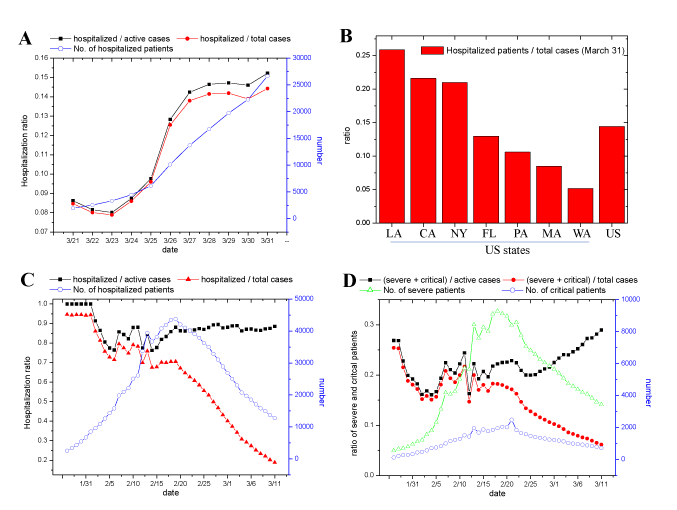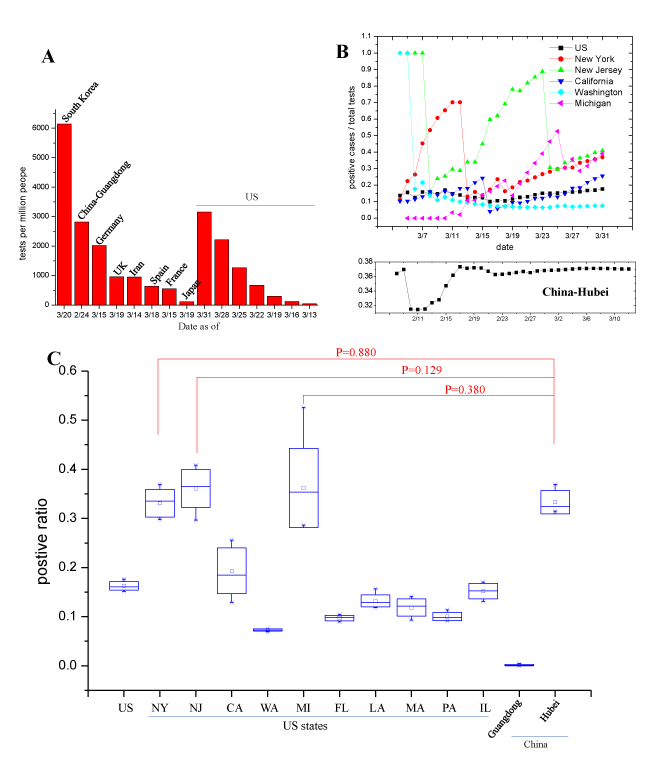Comparative Analyses of Hospitalization and Positive Tests Reveal More Severe COVID-19 Outbreaks in the US than in Hubei, China
Cheng Long1 and Xinmiao Fu2*
1Department of Orthopaedic, Sichuan University West China Hospital, Chengdu City, Sichuan Province 610041, China
2College of Life Sciences, Fujian Normal University, Fuzhou City, Fujian Province 350117, China
*Address for Correspondence: Xinmiao Fu, College of Life Sciences, Fujian Normal University, Fuzhou City, Fujian Province 350117, China, ORCID ID: orcid.org/0000-0003-3361-6904; E-mail: [email protected]
Submitted: 22 May 2020; Approved: 26 May 2020; Published: 27 May 2020
Citation this article: Long C, Fu X. Comparative Analyses of Hospitalization and Positive Tests Reveal More Severe COVID-19 Outbreaks in the US than in Hubei, China. American J Epidemiol Public Health. 2020;4(2): 040-043. https://dx.doi.org/10.37871/ajeph.id26
Copyright: © 2020 Long C, et al. This is an open access article distributed under the Creative Commons Attribution License, which permits unrestricted use, distribution, and reproduction in any medium, provided the original work is properly cited
Keywords: COVID-19; SARS-CoV-2; coronavirus; United States; Pandemic; Hospitalization; Positive COVID-19 tests
Download Fulltext PDF
People raise grave concerns about the COVID-19 outbreak in the United States. Here we show that the COVID-19 outbreak in the US is more severe than in Hubei, epicenter of the outbreak in China. First, hospitalization level of patients in the US is much lower than that in Hubei (below 20% vs over 80%), and therefore the un-hospitalized patients, if quarantined at home, will lead in a high risk of transmissions in households. Second, New York, New Jersey and Michigan are comparable with Hubei in the level of positive COVID-19 tests, indicating a relatively high level of infections among the populations. Our forecasting is supported by the COVID-19 progression in the US since April.
Introduction
The outbreak of the 2019 novel Coronavirus Diseases (COVID-19) caused by SARS-CoV-2 has challenged the global health governance [1,2]. In particular, people raise grave concerns about the COVID-19 epidemic in the US [2], where newly confirmed COVID-19 cases therein have dramatically increased since March 15 and cumulative cases have been over 210,000 as of April 2 [3]. In our earlier report in mid-March [4], crude fatality ratio analysis showed that the COVID-19 outbreaks in the US were similar to Hubei Province and its capital Wuhan City (the epicenter of the COVID-19 outbreak in China [5]. Here, we evaluated the COVID-19 outbreaks in the US by comparing its hospitalization level and the level of positive COVID-19 tests with Hubei Province and found that the former is even more severe than the latter.
Methods
Data source for analysis
The data of COVID-19 testing density as of March 31 were obtained from One World in Data (https://ourworldindata.org/grapher/covid19-tests-per-million-people). Positive, negative, and hospitalized cases in the US and all the states as of March 31 were downloaded from the website of COVDI-19 Tracking Project (https://covidtracking.com/api/). Data of Hubei COVID-19 patients were collected form the website of Hubei Provincial Health Commission (http://wjw.hubei.gov.cn/fbjd/dtyw/). Recovered patients of the US over time were collected from the COVID-19 data site of worldometer (https://www.worldometers.info/coronavirus/country/us/).
Statistical analysis
Difference analysis of the levels of positive COVID-19 tests between US states and Hubei using SPSS software with ANOVA algorithm.
Results
Hospitalization level of COVID-19 patients in US is much lower than that in Hubei
When looking at the data released by the COVID Tracking Project [6], we surprisingly found that hospitalized patients are much less than the cumulative COVID-19 cases with respect to the US or each state of the country (for detail, refer to S1.xlsx). Quantitative analysis revealed that along the development of the outbreak in late March the nationwide hospitalization level was increased from 8% to 15% (Figure 1A) and the level in New York State was elevated from 15% to 20% (Figure S1). Regarding other states, hospitalization levels ranged from 5%-25% on March 31 (Figure 1B and Table S1). In contrast, the hospitalization level in Hubei was nearly 100% around January 31 and kept above 85% even if the active COVID-19 cases reached a maximum of 44,000 around February 18 (Figure 1C). Notably, we observed that the ratio of severe and critical COVID-19 patients among active cases in Hubei varied from 15-30% (Figure 1D), which is comparable with the hospitalization levels in US states (Figure 1A, 1B and Table S1). In view of these observations, it appears that in the US only severe and critical patients are hospitalized while mild patients may not.
Levels of COVID-19 positive tests in the most affected states of US are comparable with that in Hubei
COVID-19 testing capacity in the US has been widely criticized [7]. Fortunately, the testing density (per million people) in the US has been improved since middle March (Figure 2A) and even surpassed Guangdong Province, China, where a total of 1353 COVID-19 cases have reported as of March 13 among a population of 113 millions. Nevertheless, the levels of positive COVID-19 tests in US states varied from 3-40% [6], much higher than that in Guangdong where only 0.14% of approximately 320,000 fever clinic screenings were positive for COVID-19 [8]. We then collected the data of negative cases among susceptible cases for Hubei [9] and found that the levels of positive COVID-19 tests varied from 32-38% since February 9 (the lower part of figure 2B), in contrast to that in US states varied drastically (the upper part of figure 2B and figure S2A).
To fully uncover the characteristics of positive tests in the US, a period of 7 days (i.e., 25-31 March when the testing capacity in the US has been maximized; refer to figure 2A) was set for comparison with the period of 7 days in Hubei, i.e., 9-15 February when newly confirmed cases have reached maximal numbers (refer to figure 1C). Results displayed in figure 2C revealed that the levels of positive COVID-19 tests in New York, New Jersey and Michigan were not significantly different from that in Hubei (p being 0.88, 0.129 and 0.38, respectively). This result suggests that the COVID-19 infection levels among the populations in these states are as high as that in Hubei.
Discussion
Our observations undoubtedly indicate the extremely severe (or even more severe than Hubei) COVID-19 outbreaks in the US. First, low hospitalization levels (Figure 1) indicate that a majority of COVID-19 patients in the US (most likely those mild patients) have not been hospitalized but quarantined at home, which will definitely lead to a high risk of transmissions in households. Furthermore, if these un-hospitalized patients are free to go outside, they will become mobile infectious origins, thus accelerating the spread of the virus. The difference between hospitals- and home-based isolation of COVID-19 confirmed cases has been well documented [10,11]. As a matter of fact, in the early stage of the outbreak in Wuhan City (the capital of Hubei Province and epicenter of the COVID-19 outbreak in China) [8]. However, a great number of hospital beds (up to 50,000) have been provided by government-directed re-allocation of acute care beds in designated hospitals and rapid construction of temporary hospitals (named Fangcang hospitals) in Wuhan as recently reported by us [2] and others [11] such that all the patients have been hospitalized as much as possible and the secondary transmission has been interrupted.
High levels of positive COVID-19 tests in several most affected US states (Figure 2) indicate a relatively high level of COVDI-19 infections among the populations at present, most likely due to the transmissions in households and communities as discussed above. It should be kept in mind that the outbreaks in these states are still in explosion but not approach the peak, and thus some of these states (e.g., Michigan; refer to figure S2B) might be able to surpass Hubei in the level of positive tests in the coming weeks. Furthermore, although other states are less than Hubei in the level of positive tests at present, some of them (e.g., California and Illinois; refer to figure S2B) might be able to be comparable with Hubei in the future. Collectively, both high level of COVID-19 infections and high risk of transmissions in the US at present suggest an extremely severe epidemic in the coming months, and comprehensive measures are thus urgently needed to contain this unprecedented crisis.
Our projected COVID-19 epidemics in the US, though being based on the data as of March 31, appear to be supported by the astonishing increase of COVID-19 cases in the US in April and May. Unfortunately, no more comprehensive prevention and control measures have been implemented in the US since lockdown was issued in most states in late March. The epidemics in the US at present are really more severe than in that in Hubei, China. More severely, the federal government and local governments in several US states are attempting to relax the restrictions for work resuming and economic restorations since late April. This may accelerate the spread of the virus to the whole populations, leading to the resurgence of the COVID-19 epidemics in the US.
Acknowledgments
This work is support by the National Natural Science Foundation of China (No. 31972918 and 31770830 to XF).
Author Contributions
X.F. conceptually designed the study; C. L. collected data and performed analysis; X.F. wrote the manuscript.
- Han Q, Lin Q, Jin S, You L. Coronavirus 2019-nCoV: A brief perspective from the front line. J Infect. 2020; 80: 373-377. PubMed: https://pubmed.ncbi.nlm.nih.gov/32109444/
- Zhang Z, Yao Y, Wang Y, Long C, Fu X. Wuhan and Hubei COVID-19 mortality analysis reveals the critical role of timely supply of medical resources. J Infect. 2020; S0163-4453. PubMed: https://pubmed.ncbi.nlm.nih.gov/32209384/
- Worldometer: COVID-19 CORONAVIRUS PANDEMIC. https://bit.ly/2zy4sBP
- Lv B, Li Z, Chen Y, Long C, Fu X. Global COVID-19 fatality analysis reveals Hubei-like countries potentially with severe outbreaks. J Infect. 2020; S0163-4453. PubMed: https://pubmed.ncbi.nlm.nih.gov/32302605/
- WHO: Coronavirus disease (COVID-2019) situation reports. https://bit.ly/2ZGjUqf; The COVID Tracking Project. https://bit.ly/3ghSVax
- COVID-19 in US and Canada. https://bit.ly/2LWdRpu
- The lost month: How a failure to test blinded the U.S. to COVID-19. https://bit.ly/3c1GBHZ
- (2020) Report of the WHO-China Joint Mission on Coronavirus Disease 2019 (COVID-19). https://bit.ly/2M0CO3a
- National Health Commission of China: Update of the COVID-19 outbreak data (in Chinese). https://bit.ly/3gxJBzs
- Dickens BL, Koo JR, Wilder-Smith A, Cook AR. Institutional, not home-based, isolation could contain the COVID-19 outbreak. Lancet. 2020; 395: 1541-1542. https://bit.ly/3gqqVRS
- Chen S, Zhang Z, Yang J, Wang J, Zhai X, Bärnighausen T, et al. Fangcang shelter hospitals: A novel concept for responding to public health emergencies. Lancet. 2020; 395: 1305-1314. https://bit.ly/2ZC1pTV



Sign up for Article Alerts